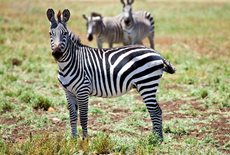
Ernest Hemingway came to Africa at a restless period of his life. Married to his second wife, Pauline Pfeiffer, already a father of three, with two of his great novels (
The Sun Also Rises and
A Farewell to Arms) under his belt, Hemingway was searching - some said desperately - for broad new horizons.
In 1933, he and Pauline traveled for 10 weeks in Africa, making their way from Mombasa to Nairobi and on to Machos in Kenya. They then moved on to the Serengeti, where Hemingway hunted, finishing up around Lake Manyara and finally on to what today is the Tarangire National Park. While in Africa, Hemingway immersed himself deeply in the local culture, uncommon for a white traveller in those days, learned the local language, and gained a fair understanding of the Kenyan people.
His time in Africa inspired some of Hemingway's best-known works: his non-fiction account of his hunting trip
Green Hills of Africa, and the short stories "The Short Happy Life of Francis Macomber," and "The Snows of Kilimanjaro," the latter based on his experiences being evacuated by plane past Kilimanjaro to Nairobi after contracting amoebic dysentery. Recuperating in Nairobi, he was befriended by Baron Bror Blixen, the husband of the Danish writer, Karen Blixen, that other great chronicler of Kenya and author of
Out of Africa.
Green Hills of Africa met with mixed reviews, though all agreed with reviewer C.G. Poore of
The New York Times, that "Africa is thoroughly in the book." With vivid descriptions of the African landscape and wildlife and mouthwateringly evocative writing, Hemingway describes not only the vast canvas of Africa and the thrill he gets from hunting but many of his views on writing and world literature. Poore acknowledged that his writing was, "…better than ever, fuller, richer, deeper and only looking for something that can use its full power. There should soon be rousing calls demanding that he go to work on a novel of vast and striking scope instead of wasting time calling shots on the kudu. There's a lot in that. He should. Maybe he plans to. If so he's taking his time about it."
Hemingway blamed critics like Poore for ruining
Green Hills of Africa, but perhaps there was something in the acid-tongued critic penned; Hemingway's arguably best and greatest novel was still to come:
For Whom the Bell Tolls, based on his experiences covering the Spanish Civil War.
On Hemingway's second trip to Africa in the winter of 1953-1954, death seemed to be nipping the great writer, now in the throes of a full-blown struggle with alcoholism, at his heels. Travelling with his fourth and last wife, Mary, he seemed thwarted at every pass, getting caught up in the Mau-Mau rebellion, he was declared dead at least twice, which afforded Hemingway the unusual opportunity to read his own obituary notice. Flying from Nairobi to Bukavo, his plane made numerous emergency landings and two crashes in Uganda, which left both Hemingways badly injured.
Using his favorite device of thinly-veiled autobiography as fiction, Hemingway wrote about this last visit in an unfinished manuscript called "True at First Light," finished posthumously by his son, Patrick and published in 1999.
Hemingway is believed to be responsible for introducing the word "safari" into mainstream English. Alexander + Roberts take pride in introducing today’s explorers to this unforgettable way to experience the wonders of Africa through carefully-crafted itineraries such as
On Safari in Kenya & Tanzania, always capped at 16 guests to ensure an intimate journey of a lifetime.